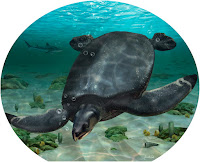 |
| Leviathanochelys aenigmatica Castillo-Visa, Luján, Galobart & Sellés, 2022 |
Abstract
Marine turtles were common in the subtropical Upper Cretaceous epi-continental seas that once washed the coasts of the ancient European archipelago. But unlike its contemporaneous faunas from North America, in Europe no taxon surpassed the 1.5 m shell-length. Here, the remains of a new large marine turtle, Leviathanochelys aenigmatica gen. et sp. nov., from the Middle Campanian of the Southern Pyrenees are described. Anatomical and histological evidence concur in identifying the specimen as a basal chelonioid. The new taxon autapomorphically differs from other marine turtles by possessing an additional process on the anteromedial side of the pelvis, and an acetabulum directed strongly ventrally. Based on the pelvis size, it is likely that Leviathanochelys was as large as Archelon, thus becoming one of the largest marine turtles found to ever exist. The large body size of the new taxon could have evolved as a response to the unique habitat conditions of the European Cretaceous archipelago seas. The presence of the accessory pubic process further suggests the occurrence of an additional insertion point of the Musculus rectus abdominis, which together with the paleohistologic evidences support the hypothesis that the new taxon had an open marine pelagic lifestyle.
Systematic palaeontology
Testudines Batsch, 1788.
Cryptodira Cope, 1868.
Chelonioidea Baur, 1893.
Leviathanochelys aenigmatica gen. et sp. nov.
Etymology: The generic name is composed of the following words: Leviathan, in reference to the Biblical marine beast, in allusion to the body size of the new species; and chelys, Latinized name from the ancient Greek χέλυς (“khélūs” meaning turtle in feminine gender). The specific nomination aenigmatica, Latinized adjective from the Greek noun αἴνιγμα (“aínigma” meaning enigma, conundrum or riddle) is in reference to the peculiar anatomical characteristics of its pelvis and carapace.
Type locality and age: Cal Torrades, Coll de Nargó (Lleida Province, Catalonia, North-eastern Spain). Lower part of the Perles Formation, Middle Campanian, Upper Cretaceous.
Diagnosis: Large-sized basal chelonioid defined by the following and unique combination of characters: reduction of the costal plates ossification without a sutural contact between costals and peripherals; carapacial plate margins (costals 5–8 and neurals 5–8) finely sutured; hexagonal/octagonal neural plates, longer than wide, that prevent the costals 6–7 from contacting one another; posterior costal plates that are rectangular-shaped, much wider than long; oval articular area of the ilium, located near the lateral margin of the right costal 8; H-shaped pelvis; enlarged and flat lateral pubic process; conspicuously ornamented, textured surface surrounding the acetabular region; extremely elongated iliac neck; and the absence of carapacial scute sulci, keels, or ornamentation on the external part of the carapace, and absence of the ilium’s posterior notch. Leviathanochelys aenigmatica is further diagnosed by having two autapomorphic characters as follows: accessory process on the anteromedial margin of the pubis; and acetabulum strongly ventrolaterally directed.
Oscar Castillo-Visa, Àngel H. Luján, Àngel Galobart and Albert Sellés. 2022. A Gigantic Bizarre Marine Turtle (Testudines: Chelonioidea) from the Middle Campanian (Late Cretaceous) of South-western Europe. Scientific Reports. 12: 18322. DOI: 10.1038/s41598-022-22619-w
https://phys.org/news/2022-11-fossil-largest-marine-turtles.html







